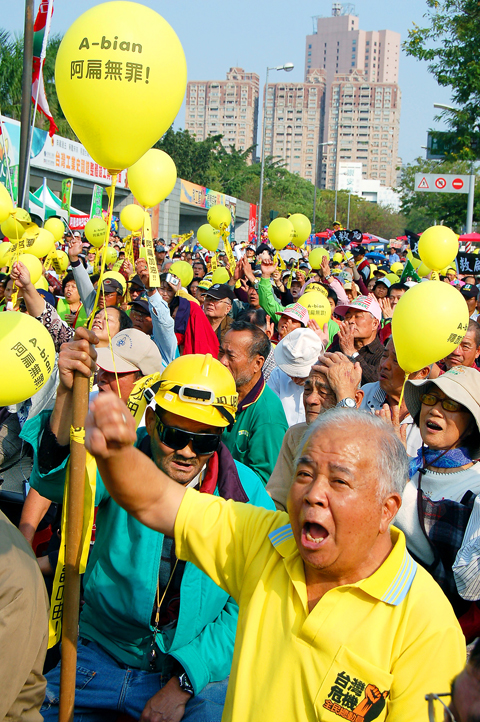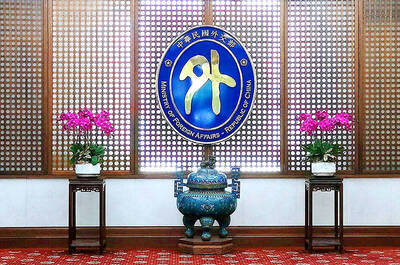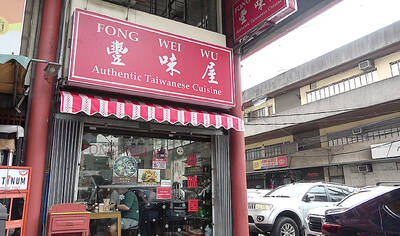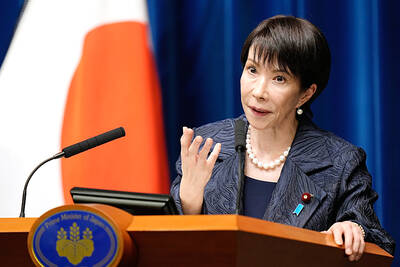The so-called “1992 consensus” between Taiwan and China never existed and is nothing but a lie, former president Chen Shui-bian (陳水扁) said yesterday.
In an excerpt of an interview published by the Chinese-language Formosa Weekly, which was founded by former vice president Annette Lu (呂秀蓮), Chen described the “one China, different interpretations consensus” President Ma Ying-jeou (馬英九) has been insisting on as “the biggest lie in history.”
Chen referred to talks between former president Lee Teng-hui (李登輝), former Mainland Affairs Council chairman Huang Kun-hui (黃昆輝) and late Straits Exchange Foundation chairman Koo Chen-fu (辜振甫) to support his argument, saying it would be impossible for Ma to help Taiwanese reach a consensus regarding cross-strait issues based on the “1992 consensus.”

PHOTO: HOU CHENG-TAN, TAIPEI TIMES
Chen said he did not support the “1992 consensus,” which was based on “Republic of China [ROC]” or “president of the ROC.” The greatest common denominator between pan-blues and pan-green on national identity, Chen said, is “Taiwan,” not the “ROC.”
Chen said Taiwan’s democratization and future referendum proposals should focus on rejecting unification with China and protecting Taiwan.
Chen also accused Ma of lying when he said that it would be easier for Taiwan to sign free-trade agreements (FTA) with other countries after both sides of the Taiwan Strait sign an economic cooperation framework agreement (ECFA).
As Beijing never saw Taiwan as a country, but rather as a region of China, Chen said China could not agree that Taiwan is eligible to sign FTAs with other countries.
The Ma administration’s proposed ECFA originated from plans for a comprehensive economic cooperation agreement (CECA) with China. A CECA is similar to the comprehensive economic partnership agreement (CEPA) that was intended to “build closer economic and trade ties between Hong Kong and China,” Chen said.
Given China’s refusal to abandon the military option against Taiwan and the growing number of missiles it aims at it, any negotiations on a cross-strait peace agreement and establishment of cross-strait military security mechanisms would be made under a “one China” precondition, Chen said.
Chen said Ma was unlikely to benefit from his cross-strait policy in his re-election bid.
Chen has been confined at the Taipei Detention House in Tucheng (土城), Taipei County, since December 2008 on charges of corruption, money laundering and embezzlement.
Both Chen and his wife, Wu Shu-jen (吳淑珍), were sentenced on Sept. 11 by the Taipei District Court to life in prison on several counts of corruption.

The Ministry of Foreign Affairs (MOFA) yesterday voiced dissatisfaction with the Comprehensive and Progressive Agreement for Trans- Pacific Partnership (CPTPP), whose latest meeting, concluded earlier the same day, appeared not to address the country’s application. In a statement, MOFA said the CPTPP commission had "once again failed to fairly process Taiwan’s application," attributing the inaction to the bloc’s "succumbing to political pressure," without elaborating. Taiwan submitted its CPTPP application under the name "Separate Customs Territory of Taiwan, Penghu, Kinmen and Matsu" on Sept. 22, 2021 -- less than a week after China

THE GOOD WORD: More than 100 colleges on both sides of the Pacific will work together to bring students to Taiwan so they can learn Mandarin where it is spoken A total of 102 universities from Taiwan and the US are collaborating in a push to promote Taiwan as the first-choice place to learn Mandarin, with seven Mandarin learning centers stood up in the US to train and support teachers, the Foundation for International Cooperation in Higher Education of Taiwan (FICHET) said. At the annual convention of the American Council on the Teaching of Foreign Languages held over the weekend in New Orleans, Louisiana, a Taiwan Pavilion was jointly run by 17 representative teams from the FICHET, the Overseas Community Affairs Council, the Steering Committee for the Test of Proficiency-Huayu, the

A home-style restaurant opened by a Taiwanese woman in Quezon City in Metro Manila has been featured in the first-ever Michelin Guide honoring exceptional restaurants in the Philippines. The restaurant, Fong Wei Wu (豐味屋), was one of 74 eateries to receive a “Michelin Selected” honor in the guide, while one restaurant received two Michelin stars, eight received one star and 25 were awarded a “Bib Gourmand.” The guide, which was limited to restaurants in Metro Manila and Cebu, was published on Oct. 30. In an interview, Feng Wei Wu’s owner and chef, Linda, said that as a restaurateur in her 60s, receiving an

MORE RETALIATION: China would adopt a long-term pressure strategy to prevent other countries or future prime ministers following in Sanae Takaichi’s steps, an academic said Taiwan should maintain communications with Japan, as Japanese Prime Minister Sanae Takaichi is to lead a revision of security documents, Taiwanese academics said yesterday. Tensions have risen between Japan and China over remarks by Takaichi earlier this month that the use of force against Taiwan would constitute a “survival-threatening situation” for Japan. Prospect Foundation president Lai I-chung (賴怡忠) yesterday said Takaichi’s stance regarding Taiwan is the same as past Japanese prime ministers, but her position is clearer than that of her predecessors Fumio Kishida and Shigeru Ishiba. Although Japan views a “Taiwan contingency” as a “survival-threatening situation,” which would allow its military to